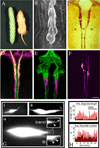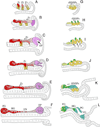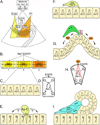How to innervate a simple gut: familiar themes and unique aspects in the formation of the insect enteric nervous system
- PMID: 17420985
- PMCID: PMC3097047
- DOI: 10.1002/dvdy.21138
How to innervate a simple gut: familiar themes and unique aspects in the formation of the insect enteric nervous system
Abstract
Like the vertebrate enteric nervous system (ENS), the insect ENS consists of interconnected ganglia and nerve plexuses that control gut motility. However, the insect ENS lies superficially on the gut musculature, and its component cells can be individually imaged and manipulated within cultured embryos. Enteric neurons and glial precursors arise via epithelial-to-mesenchymal transitions that resemble the generation of neural crest cells and sensory placodes in vertebrates; most cells then migrate extensive distances before differentiating. A balance of proneural and neurogenic genes regulates the morphogenetic programs that produce distinct structures within the insect ENS. In vivo studies have also begun to decipher the mechanisms by which enteric neurons integrate multiple guidance cues to select their pathways. Despite important differences between the ENS of vertebrates and invertebrates, common features in their programs of neurogenesis, migration, and differentiation suggest that these relatively simple preparations may provide insights into similar developmental processes in more complex systems.
Copyright 2007 Wiley-Liss, Inc.
Figures






Similar articles
-
Development of the intrinsic and extrinsic innervation of the gut.Dev Biol. 2016 Sep 15;417(2):158-67. doi: 10.1016/j.ydbio.2016.04.016. Epub 2016 Apr 22. Dev Biol. 2016. PMID: 27112528 Review.
-
Enteric nervous system assembly: Functional integration within the developing gut.Dev Biol. 2016 Sep 15;417(2):168-81. doi: 10.1016/j.ydbio.2016.05.030. Epub 2016 May 26. Dev Biol. 2016. PMID: 27235816 Review.
-
Neuron-Glia Interaction in the Developing and Adult Enteric Nervous System.Cells. 2020 Dec 31;10(1):47. doi: 10.3390/cells10010047. Cells. 2020. PMID: 33396231 Free PMC article. Review.
-
Enteric nervous system development: migration, differentiation, and disease.Am J Physiol Gastrointest Liver Physiol. 2013 Jul 1;305(1):G1-24. doi: 10.1152/ajpgi.00452.2012. Epub 2013 May 2. Am J Physiol Gastrointest Liver Physiol. 2013. PMID: 23639815 Free PMC article. Review.
-
The nature of catecholamine-containing neurons in the enteric nervous system in relationship with organogenesis, normal human anatomy and neurodegeneration.Arch Ital Biol. 2017 Sep 1;155(3):118-130. doi: 10.12871/00039829201733. Arch Ital Biol. 2017. PMID: 29220864 Review.
Cited by
-
Reverse signaling by glycosylphosphatidylinositol-linked Manduca ephrin requires a SRC family kinase to restrict neuronal migration in vivo.J Neurosci. 2009 Mar 18;29(11):3404-18. doi: 10.1523/JNEUROSCI.5464-08.2009. J Neurosci. 2009. PMID: 19295147 Free PMC article.
-
Gut pathology and responses to the microsporidium Nosema ceranae in the honey bee Apis mellifera.PLoS One. 2012;7(5):e37017. doi: 10.1371/journal.pone.0037017. Epub 2012 May 18. PLoS One. 2012. PMID: 22623972 Free PMC article.
-
Evolution of nitric oxide regulation of gut function.Proc Natl Acad Sci U S A. 2019 Mar 19;116(12):5607-5612. doi: 10.1073/pnas.1816973116. Epub 2019 Mar 4. Proc Natl Acad Sci U S A. 2019. PMID: 30833398 Free PMC article.
-
Neuronal migration during development and the amyloid precursor protein.Curr Opin Insect Sci. 2016 Dec;18:1-10. doi: 10.1016/j.cois.2016.08.001. Epub 2016 Aug 16. Curr Opin Insect Sci. 2016. PMID: 27939704 Free PMC article. Review.
-
Fasciclin 2 plays multiple roles in promoting cell migration within the developing nervous system of Manduca sexta.Dev Biol. 2023 Jul;499:31-46. doi: 10.1016/j.ydbio.2023.04.009. Epub 2023 Apr 28. Dev Biol. 2023. PMID: 37121309 Free PMC article.
References
-
- Airaksinen MS, Holm L, Hatinen T. Evolution of the GDNF family ligands and receptors. Brain Behav Evol. 2006;68:181–190. - PubMed
-
- Anderson DJ. Stem cells and transcription factors in the development of the mammalian neural crest. Faseb J. 1994;8:707–713. - PubMed
-
- Anderson DJ. Lineages and transcription factors in the specification of vertebrate primary sensory neurons. Curr Opin Neurobiol. 1999;9:517–524. - PubMed
-
- Anderson RB, Turner KN, Nikonenko AG, Hemperly J, Schachner M, Young HM. The cell adhesion molecule L1 is required for chain migration of neural crest cells in the developing mouse gut. Gastroenterology. 2006;130:1221–1232. - PubMed
Publication types
MeSH terms
Grants and funding
LinkOut - more resources
Full Text Sources

